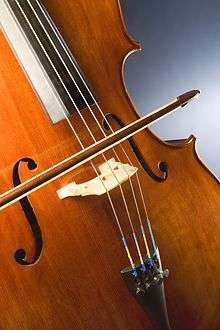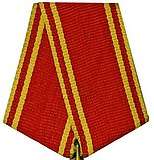Cello concertos (Kabalevsky)
Dmitri Kabalevsky composed two cello concertos. He was a Russian composer who lived during the 20th century from 1904–1987.[1] Primarily a pianist and composer for piano, he also wrote two concertos for cello.[1] Kabalevsky had a career as a music educator, composer and member of the International Society for Music Education (ISME).[2] Kabalevsky's works have been regarded unfavorably by many because of his associations and allegiance with the Communist Party and is referred to by some as a "Soviet Composer", who was "self-serving, sly, and opportunistic to the extreme."[3] However, his compositions including the two cello concertos are widely used by various students around the world to learn technique and musicality.[3]
Background
Early years and influences
Kabalevsky was elected vice president of the ISME in 1968, during the 8th conference meeting held in Dijon, France.[2] He also had political prestige because of his efforts to reform music education in Soviet Russia. For example, he was awarded the Order of Lenin for his contribution to Russian music education.[4] He also received a Medal of Honour from the Soviet Government "for his musical prowess."[5]
It is generally accepted that a composer's context has a great influence on their compositions. Kabalevsky's life in Russia during the time of the USSR and his career as a music teacher, for example, held particular influences on his works, particularly on his cello concertos.[6] During World War II, Russian and German governments had strict rules about the arts and what was appropriate and they generally preferred pieces that promoted patriotism for their country. As a result, Kabalevsky did not stray too far from traditional Russian music in his cello concertos.[3] The war and post-war context brought new inspiration to many composers including Kabalevsky, as seen by the number of famous compositions that came out of this time. This includes some of the works by Ralph Vaughan Williams, Dmitri Shostakovich and Samuel Barber (amongst many others).[7] The cello itself gained particular attention during this inter-war period, with the composition of several cello pieces such as Prokofiev's Cello Concerto and Shostakovich's pair of Cello Concertos, as well as Kabalevsky's own.[8]
The 20th century brought about a new style known as neoclassicism[9] which Kabalevsky adhered to in many of his works, but particularly in his cello concertos. This style came about during the inter-war period, where innovation in music was less desirable and where tradition took precedence.[9] The neoclassical style was not rigid in traditional forms however, and there was some room for experimentation.[9]
Concerto
A concerto is a piece of music highlighting the stylistic qualities of a particular instrument through solo playing with the accompaniment of an orchestra.[10] Another main feature of the concerto is the cadenza, which is a section of the piece often written by the soloist which fits within any or all or some of the movements. Throughout time, concertos have varied in their form and instrumentation but the most traditional and commonly used structure is three movements, following a pattern of the first being fast, the second slow and the third fast again (usually faster than the first movement).[10] The instrumentation of a concerto is commonly a traditional orchestra however there are some exceptions. A standard orchestral accompaniment in a concerto consists of string, woodwind, brass and percussion sections. The Kabalevsky Cello Concertos both follow traditional instrumentation, however, Cello Concerto No. 2 has a more innovative structure than No. 1 which does adhere to traditional concerto structure.[11]
Cello Concerto No. 1
Description
Cello Concerto No. 1 is part of a trilogy of concertos by Kabalevsky and is considered to be the central piece of the trilogy.[12] The other pieces in the trilogy are his Violin Concerto, written in 1948, and Third Piano Concerto, written in 1952.[12] The three concertos were dedicated to students and young performers[12] and were written in a style that was simple enough for a student to play yet challenging enough to progress their musicality and technique. Cello Concerto No. 1 was premiered in 1949 by Sviatoslav Knushevitsky, a Russian cellist who was a student at the time.[12] He was accompanied by the Moscow Conservatory Youth Orchestra.[12]
Stylistic features
The first cello concerto is in G minor.
Cello Concerto No. 1 follows the traditional structure of a concerto as it has three movements, or sections, which follow a "fast-slow-fast" pattern. The first section is an Allegro, which means "fast and lively". It is followed by the second movement which is a Largo, meaning "slow" and was dedicated to fallen Russian soldiers in World Wars 1 and 2. The third movement is an Allegro molto, meaning "very swift".[12] As Kabalevsky's First Cello Concerto was written for students, it is not as technically challenging as Concerto No. 2.[12] It has as the features of a conventional concerto including a traditional structure and instrumentation. His use of melody and harmonic structure also followed tradition. Kabalevsky was generally praised by his audiences because of this and received a mostly positive reception to his neoclassic style.[7]
Influences
Kabalevsky drew inspiration from and was influenced by a number of things such as his context of living in Soviet Russia, the neoclassic style that came out of the inter-war period and his esteemed career as a music educator and professional. Some snippets of Eastern Folk Songs also feature in his First Cello Concerto.[12]

Cello Concerto No. 2
Description
The Second Cello Concerto is part of a trilogy of more difficult and dramatic concertos. These pieces are generally considered to be written for music tutors rather than students, as his other concertos were. The other two pieces in the trilogy are Kabalevsky's first two piano concertos. Cello Concerto No. 2 was written in 1964 and premiered by Daniel Shafran that year.[13] Shafran had previously recorded the First Cello Concerto with Kabalevsky.[13]
Stylistic features
The Second Cello Concerto is in C minor.
Cello Concerto No. 2 does not follow a traditional concerto structure like Concerto No. 1 as it has a slow-fast-slow pattern. This structure was influenced by Kabalevsky's teacher, Nikolai Myaskovsky.[13] The movements are as follows:
- Molto sostenuto – Allegro molto e energico
- Presto marcato
- Andante con moto – Allegro agitato – Molto tranquillo[14]
The names of these movements can roughly be translated to:
- very sustained – quick with much energy
- fast, accented
- moderately slow with movement – fast and restless – very calm[15]
The movements of Cello Concerto No. 2 are played attacca,[13] meaning the piece continues without breaks between the movements.[15] This was also an unusual feature of the concerto.
The instrumentation of the orchestral accompaniment to the solo cello is fairly standard, except for the inclusion of the alto saxophone.
Unlike Cello Concerto No. 1, Cello Concerto No. 2 is very raw in its expression and seems to deviate from Soviet tradition.[3] This is unusual for Kabalevsky as this sort of style does not appear in many of his compositions, particularly those during the reign of the USSR.
Influences

Nikolai Myaskovsky held a great influence on Kabalevsky's Second Cello Concerto because he was Kabalevsky's music teacher at the Moscow Conservatory.[13] Myaskovsky was also awarded with the Order of Lenin and held the rank of General in the Russian Army during World War II.[16][17] Though Myaskovsky had a good reputation with the Soviet Union to start with, his compositions began to drift away from what was acceptable and was accused of "injecting inharmonious music into the Soviet Educational System".[17] However, his generous teaching earned him the title of "the musical conscience of Moscow".[17] Myaskovsky experimented with modernist music particularly in harmony and form.[17] Kabalevsky drew inspiration from Myaskovsky's experimentation in his Cello Concerto No. 2.[13] We can see this in the changed form of the concerto, the movements structured as slow-fast-slow rather than fast-slow-fast.[18] It is also evident in Kabalevsky's more harrowing and emotional harmonies in the Second Cello Concerto.
References
- "Dmitry Kabalevsky | Biography & History". AllMusic. Retrieved 2019-05-19.
- Callaway, Frank (1987-11-01). "Dmitri Kabalevsky and ISME: A Personal Memoir". International Journal of Music Education. os-10 (1): 46–48. doi:10.1177/025576148701000113. ISSN 0255-7614.
- "Classical Net Review – Kabalevsky – Concertos". Classical Net. Retrieved 2019-05-20.
- Muckle, James (March 1987). "Dmitriy Kabalevsky and the Three Whales. Recent Developments in Music Education in the Soviet General Education School". British Journal of Music Education. 4 (1): 53–70. doi:10.1017/S0265051700005726. ISSN 0265-0517.
- "Dmitry Kabalevsky | Biography & History". AllMusic. Retrieved 2019-05-19.
- Daragan, Dina Grigor′yevna (2001), "Kabalevsky, Dmitry Borisovich", Oxford Music Online, Oxford University Press, doi:10.1093/gmo/9781561592630.article.14573
- Grout, D; Palisca, C (1988). A History of Western Music (4th ed.). London: J.M. Dent & Sons Ltd. pp. 807–880.
- McAllister, R (1980). "Kabalevsky, Dmitri Borisovich". The New Grove Dictionary of Music and Musician (1st ed.). Macmillan Publishers Ltd.: 760–762.
- "Sound Patterns: Chapter 43. Neo-classicism". academic.udayton.edu. Retrieved 2019-05-19.
- Hutchings, Arthur; Talbot, Michael; Eisen, Cliff; Botstein, Leon; Griffiths, Paul (2001). "Concerto | Grove Music". www.oxfordmusiconline.com. doi:10.1093/gmo/9781561592630.article.40737. Retrieved 2019-05-19.
- "Unsung Concertos Dmitri Kabalevsky: Cello Concerto No. 1, Op. 49". Interlude.hk. 2016-12-28. Retrieved 2019-05-19.
- Stoops, Emily. "Cello Concerto No. 1 in G minor, Op. 49". AllMusic. Retrieved 2019-05-13.
- "Dmitri KABALEVSKY – Cello Concertos [RB]: Classical CD Reviews- Feb 2003 MusicWeb(UK)". www.musicweb-international.com. Retrieved 2019-06-03.
- "Dmitri Kabalevsky – Cello Concerto No. 2 in C minor (1964), opus 77 – Music Sales Classical". www.musicsalesclassical.com. Retrieved 2019-06-03.
- Sadie, Stanley (1988). The Grove Concise Dictionary of Music. London: Macmillan Press Ltd. pp. 494, 713, 16, 596, 463, 21, 9, 775.
- Slonimsky, Nicolas (1988). A Biographical Dictionary of Composers & Musicians. Britain: Simon & Schuster Ltd. p. 846.
- Morrison, Chris. "Nikolay Myaskovsky | Biography & History". AllMusic. Retrieved 2019-06-04.
- Barnett, Rob. "Dmitri Kabalevsky". Music Web International. Retrieved 4/6/19. Check date values in:
|access-date=(help)